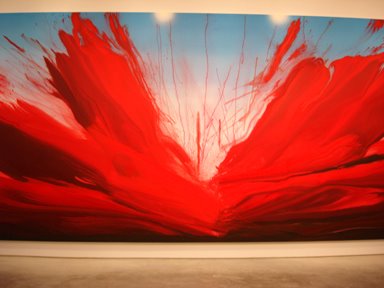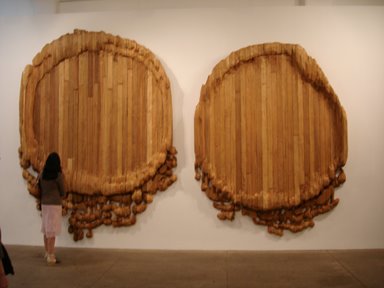According to Elisabeth Condon
Formalism created an armature for artistic progression in the 20th century. Its progression culminated in new visual discoveries exemplified by Cezanne’s petit sensation and Philip Guston’s fleshy psychology. Formal innovations at their best revealed, as Louis Finkelstein noted in his 1971 Arts magazine essay Painterly, both technical solutions and glimmerings of possible meaning.

Now movies have sequels and artists have shows. Progress in both is measured by their ability to expand on, yet remain within range of a particular direction. Making things easier, technology replaces the armature of formal innovation with the conceptual tension between all-knowing and suspended disbelief. Manipulating a direction becomes conscious and deliberate. Though the model of artistic progression retains last century’s agenda to catalyze shifts in perception, disorientation and immersion become new metaphors for heightening awareness, offset by a broader knowledge base.
Barnaby Furnas and Ursula von Rydingvard’s exhibitions approach artistic progression in different ways. At Boesky, Furnas’ mural-size Red Sea paintings adapt 1970s pour and drip techniques to transform Greenbergian formalism into epic narrative, using speed as an alchemical agent. The paintings are knockouts, working doubly as abstraction and evocations of the Biblical parting of the sea. They offer the conceptual tension of seeing v. naming to verify their knowingness. Their scale beckons our immersion but their ambition remains external. They vacillate between narrative investigation and updated postwar abstraction, settling on neither, buffeting their viewers in waves of indecision. Ursula von Rydingsvard’s wall plates at Lelong resemble giant, gilded mirrors that are muffled in cedar wood. They are obviously constructed, physically imposing objects—yet inexplicable. Their visual memory is light, belying the scope and weight of their physical presence. They appear as fully digested emblems of an artistic imagination, un-nameable as objects but possessing a level of focus that convinces without naming, immersing their viewers into a new experience, not of self-reflection, but absorption into the mysteriousness of objects.

Finkelstein favored Manet’s probing marks as more investigative than Boldini’s suave brushwork. Less Protestant but equally faithful, I consider immersion progressive, commentary facile. To not know in the face of knowing seems silly, but imagination prevails. The efficacy of the aesthetic moment lies in the transformation of experience, private or social, resulting from the genuine perceptual change that occurs in the process of making.
Formalism created an armature for artistic progression in the 20th century. Its progression culminated in new visual discoveries exemplified by Cezanne’s petit sensation and Philip Guston’s fleshy psychology. Formal innovations at their best revealed, as Louis Finkelstein noted in his 1971 Arts magazine essay Painterly, both technical solutions and glimmerings of possible meaning.

Now movies have sequels and artists have shows. Progress in both is measured by their ability to expand on, yet remain within range of a particular direction. Making things easier, technology replaces the armature of formal innovation with the conceptual tension between all-knowing and suspended disbelief. Manipulating a direction becomes conscious and deliberate. Though the model of artistic progression retains last century’s agenda to catalyze shifts in perception, disorientation and immersion become new metaphors for heightening awareness, offset by a broader knowledge base.
Barnaby Furnas and Ursula von Rydingvard’s exhibitions approach artistic progression in different ways. At Boesky, Furnas’ mural-size Red Sea paintings adapt 1970s pour and drip techniques to transform Greenbergian formalism into epic narrative, using speed as an alchemical agent. The paintings are knockouts, working doubly as abstraction and evocations of the Biblical parting of the sea. They offer the conceptual tension of seeing v. naming to verify their knowingness. Their scale beckons our immersion but their ambition remains external. They vacillate between narrative investigation and updated postwar abstraction, settling on neither, buffeting their viewers in waves of indecision. Ursula von Rydingsvard’s wall plates at Lelong resemble giant, gilded mirrors that are muffled in cedar wood. They are obviously constructed, physically imposing objects—yet inexplicable. Their visual memory is light, belying the scope and weight of their physical presence. They appear as fully digested emblems of an artistic imagination, un-nameable as objects but possessing a level of focus that convinces without naming, immersing their viewers into a new experience, not of self-reflection, but absorption into the mysteriousness of objects.

Finkelstein favored Manet’s probing marks as more investigative than Boldini’s suave brushwork. Less Protestant but equally faithful, I consider immersion progressive, commentary facile. To not know in the face of knowing seems silly, but imagination prevails. The efficacy of the aesthetic moment lies in the transformation of experience, private or social, resulting from the genuine perceptual change that occurs in the process of making.
Comments
Sweetheart! Hello. So good to see you out and about!
I am undecided, darling. I am undecided as to whether or not I understand the above paragraph. I am undecided as to whether the phrase 'verify their knowingness' has Meaning, or is mere Poetic Abstraction. I am vacillating, darling, between a desire to investigate your narrative, and a postmodern impulse to dismiss it as mere reification of an inscrutable pulsation. I feel Buffeted, my dear. I believe I must go lie down.
I hope that clarifies.
I'd like to know how others experienced both exhibitions or either one.
C'est tout.
AHHH! NOW we have an interesting, clear statement. Maybe you smashed your nose because it's a lame, pretentious project that didn't work; maybe not. I haven't been to see the show yet, so I don't know.
But why in the world do we feel we have to cover up our smashed noses with waves of polysyllabic, impenetrable, postmodern rhetoric? Does art which smashes our noses simultaneously intimidate us into dithering round like this, thinking that perhaps the flaw is in ourselves, and not the artwork, thus causing us to throw up a giant wall of intellectuality between us and it?
I care about poured paint personally, artistically, conceptually and historically. The promise of immersion with Furnas titillated and was met in Ursula von Rydingvard's work. This required historical consideration to address notions of progress, which is the purpose of Threshholding.
You did not understand that assumption because I did not make it. I made a case for the opposite situation, in fact, if you will go back and reread my question closely, paying attention to the train of logic contained within it.
You will note, dear EC, that despite the fact that David emailed his extensive mailing list with the link to this write-up, it has ended up with just the two of us holding a conversation, in a vast, silent cyber-chamber.
My hunch is that this is because the 'literary influence of theory/art reviews' is a touch off-putting. Or perhaps it is that most visual artists are not particularly verbal. Indeed, many of them can scarcely operate a computer, the poor dears.
I wish someone would discuss the idea of immersion, for not all artists believe in immersion as necesssary to the working process. But chasing after people to talk to me feels depressing. Thanks Pretty Lady for your flashlight of illumination. Though I think plenty of artists are bloggin' away.
Bye for now.